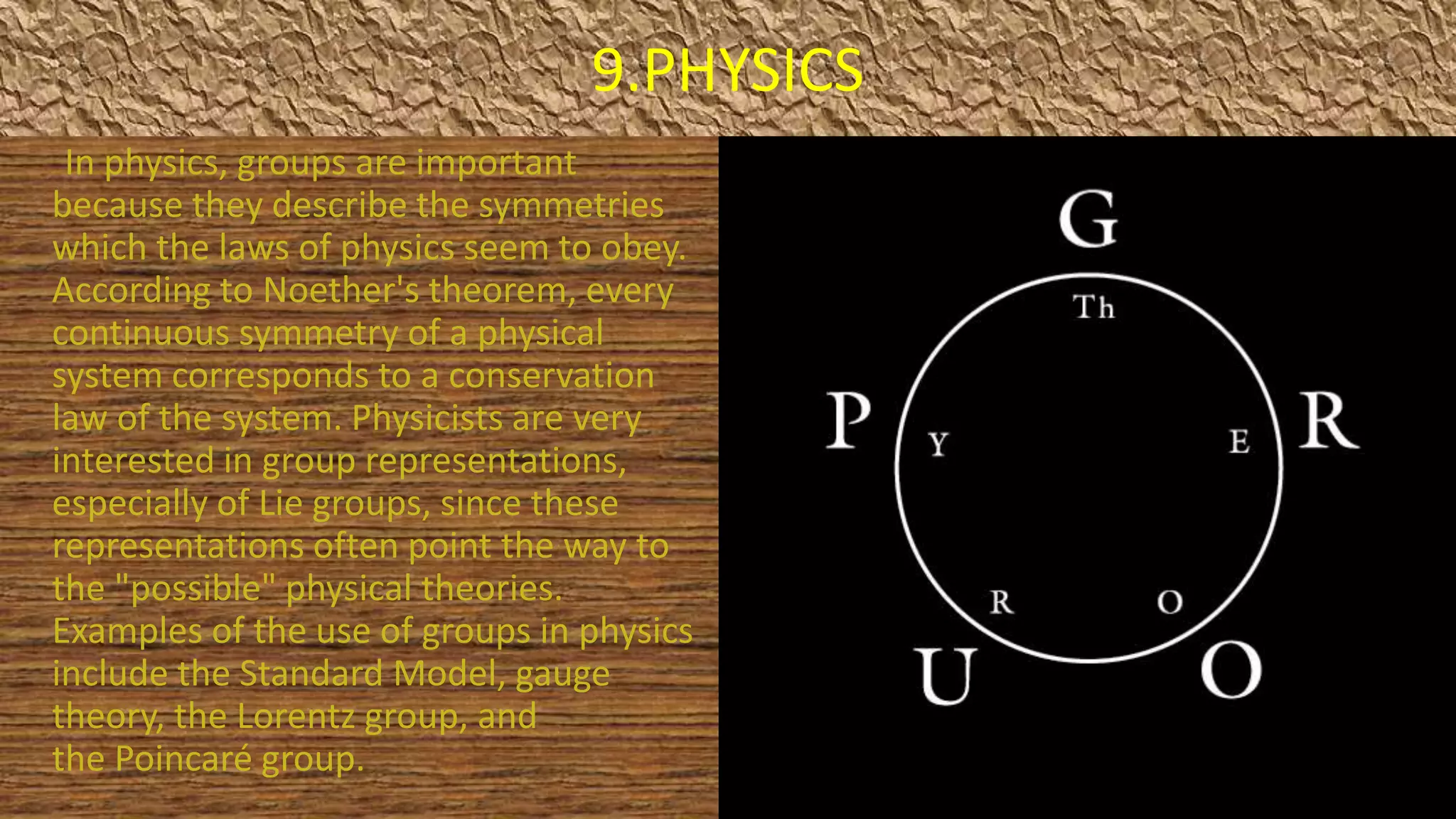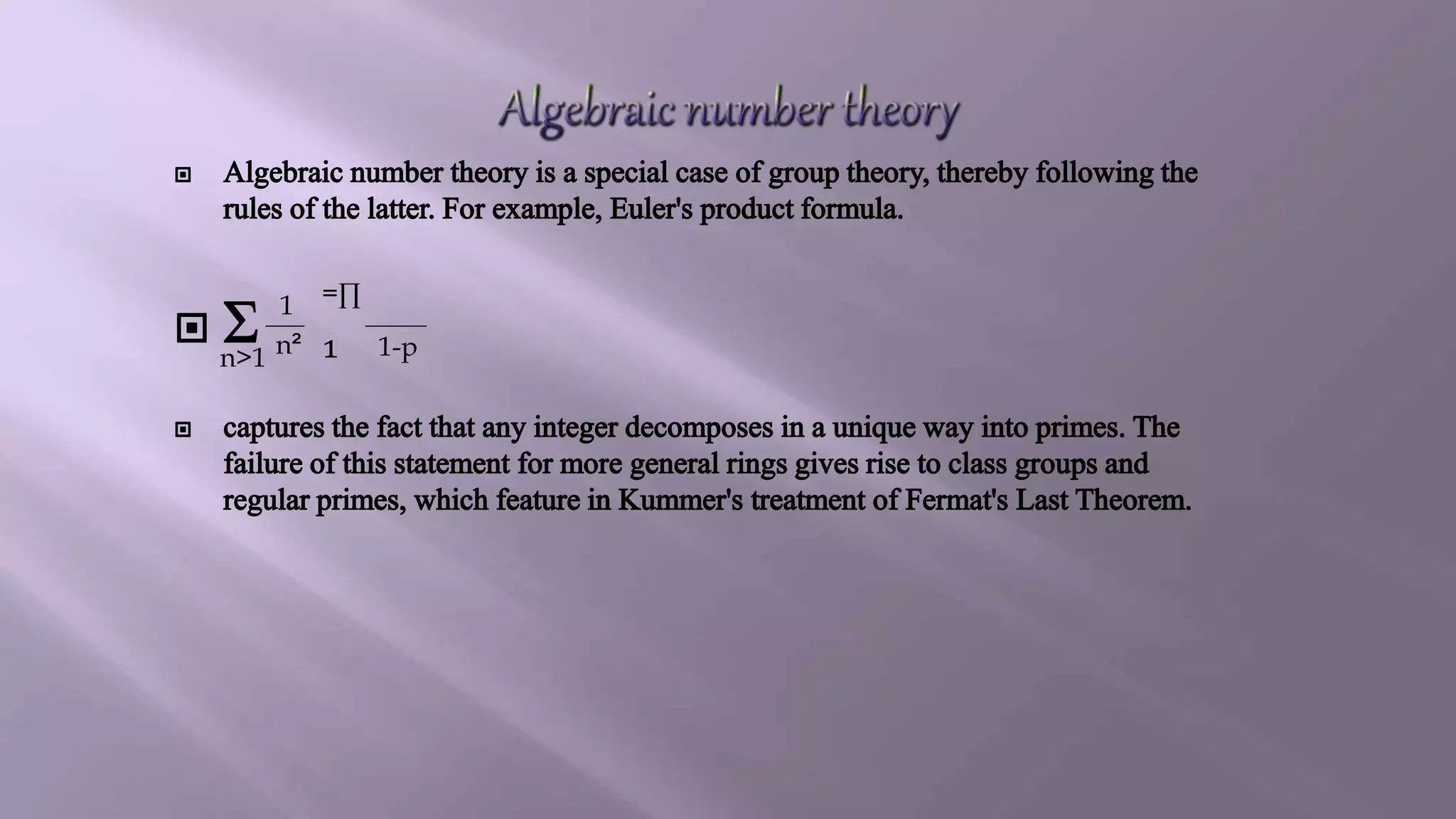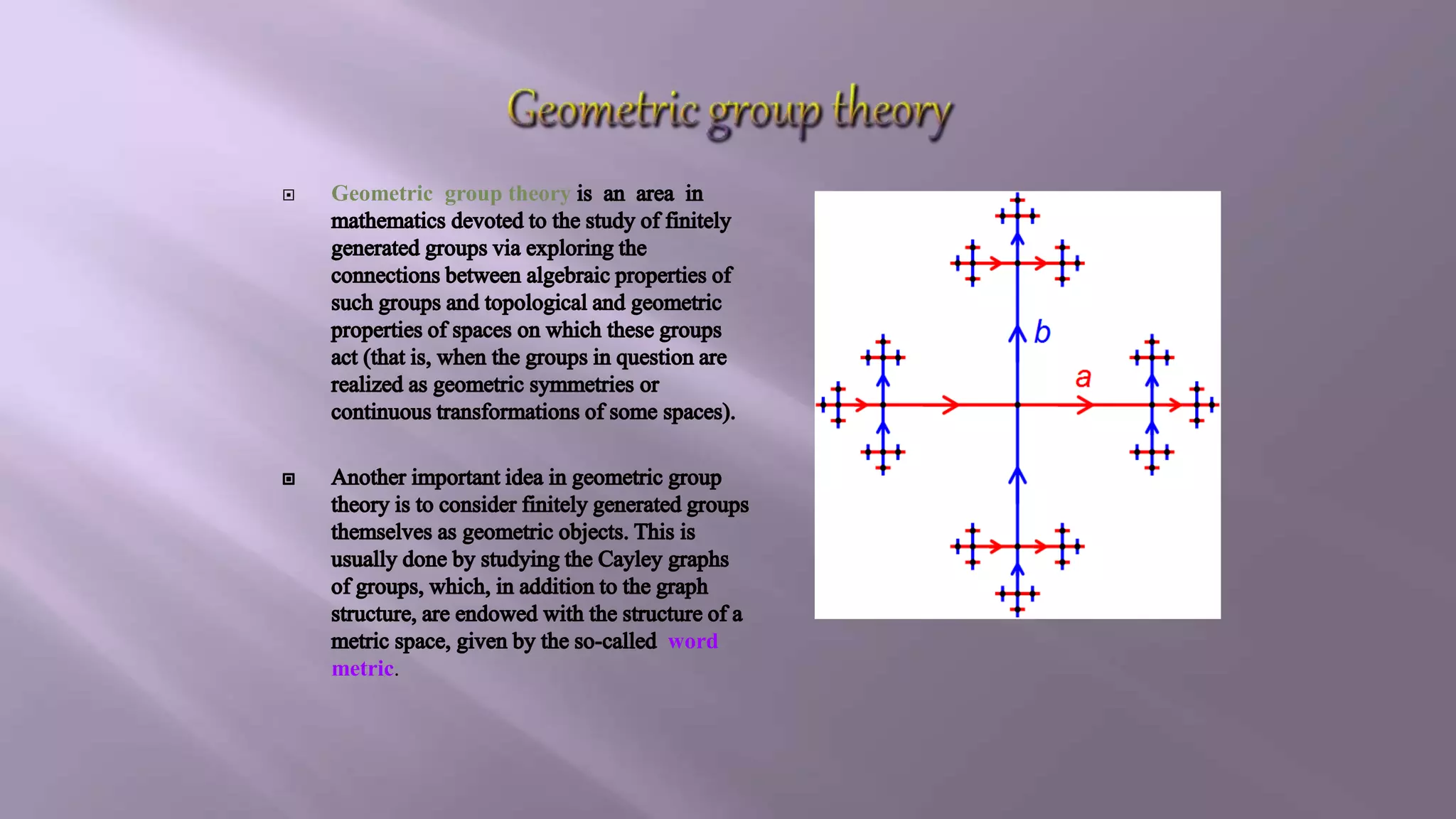The document outlines the history and branches of group theory, detailing its evolution from the 19th century to contemporary applications, including significant mathematicians' contributions. It discusses various types of Rubik's cubes, their mechanics, and records in speed-solving, illustrating the complexity and recreational aspects of group theory. Additionally, it highlights applications of group theory in fields like algebra and topology, emphasizing its foundational role in understanding algebraic structures and their symmetries.

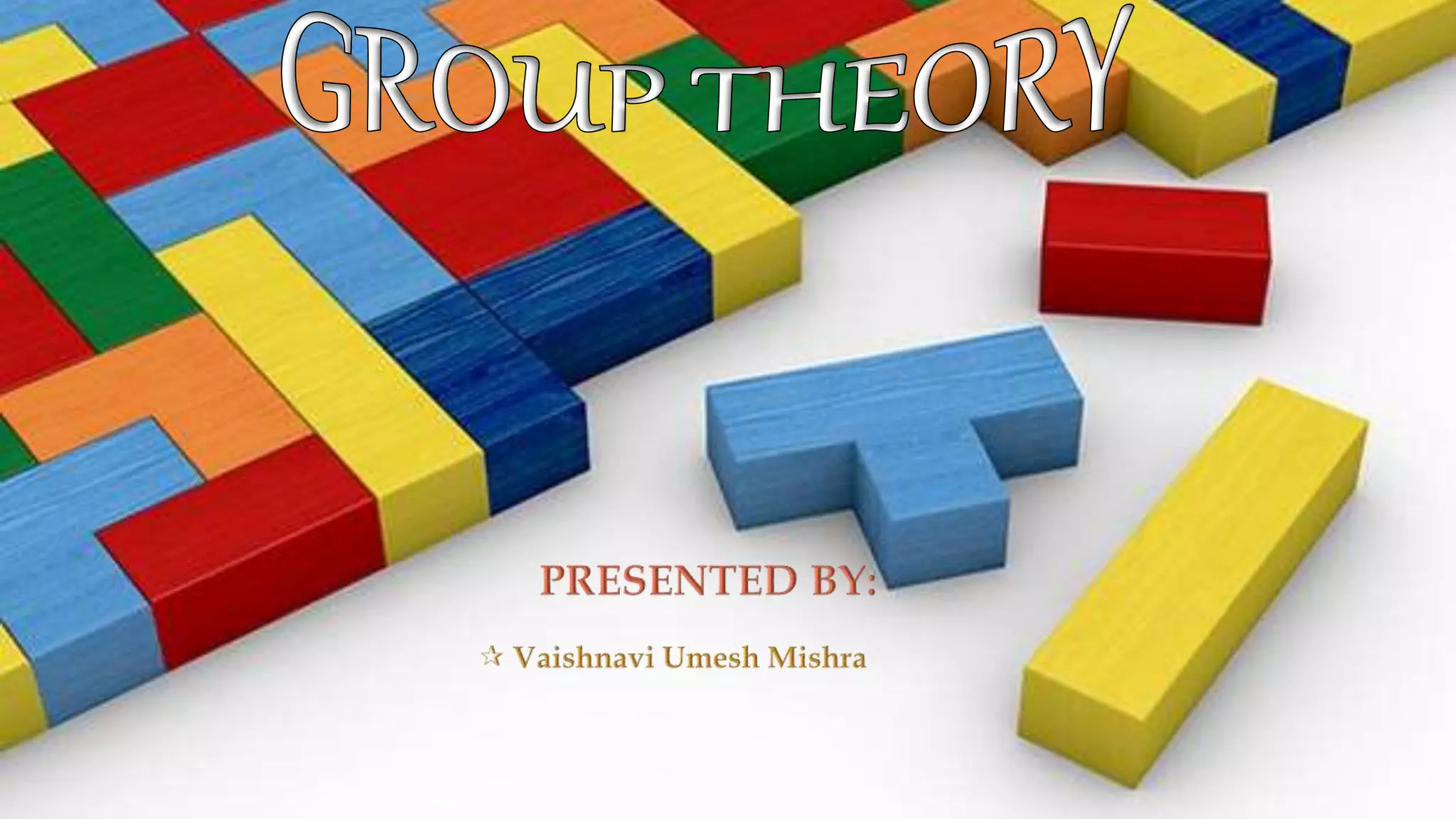
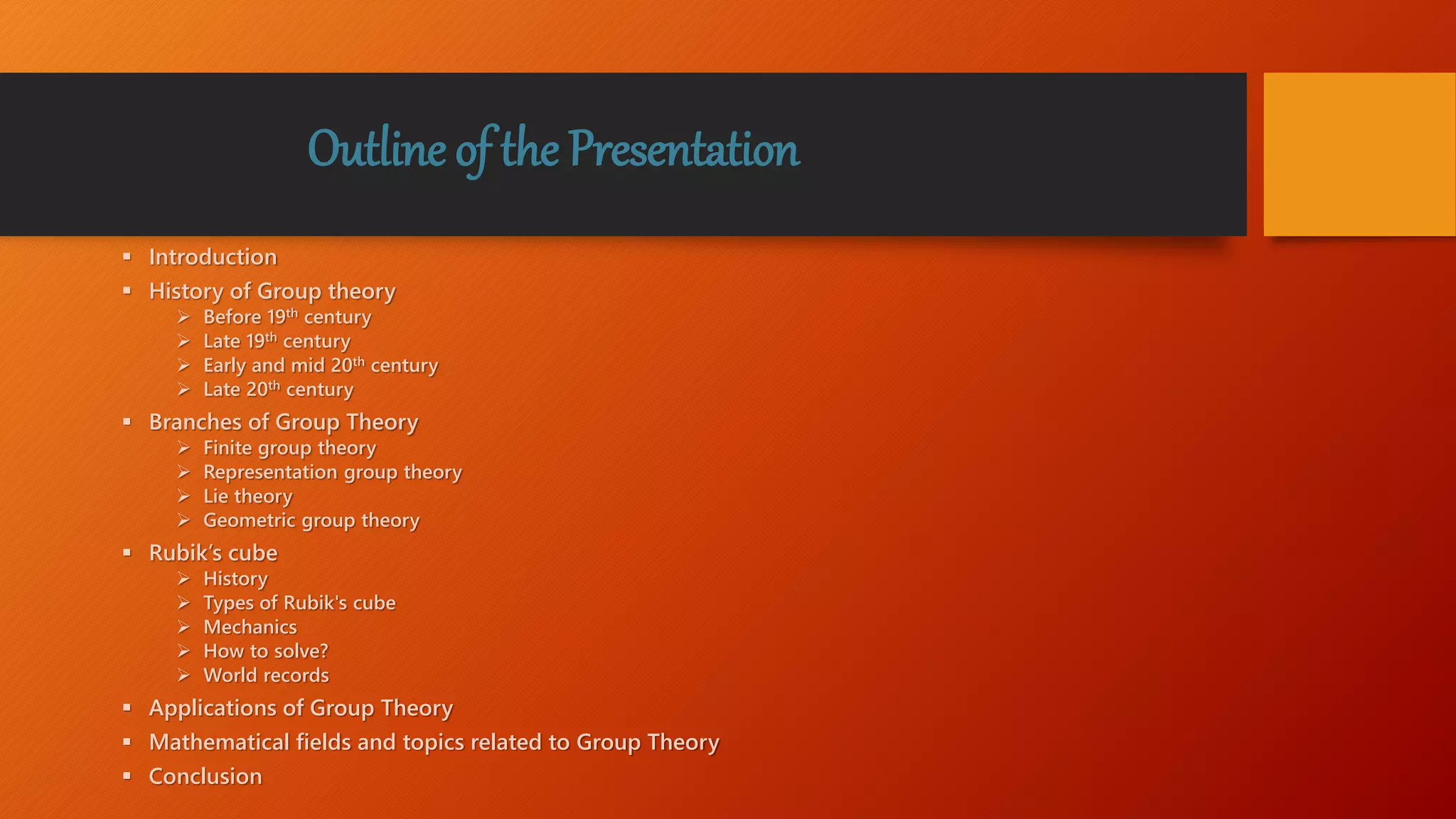



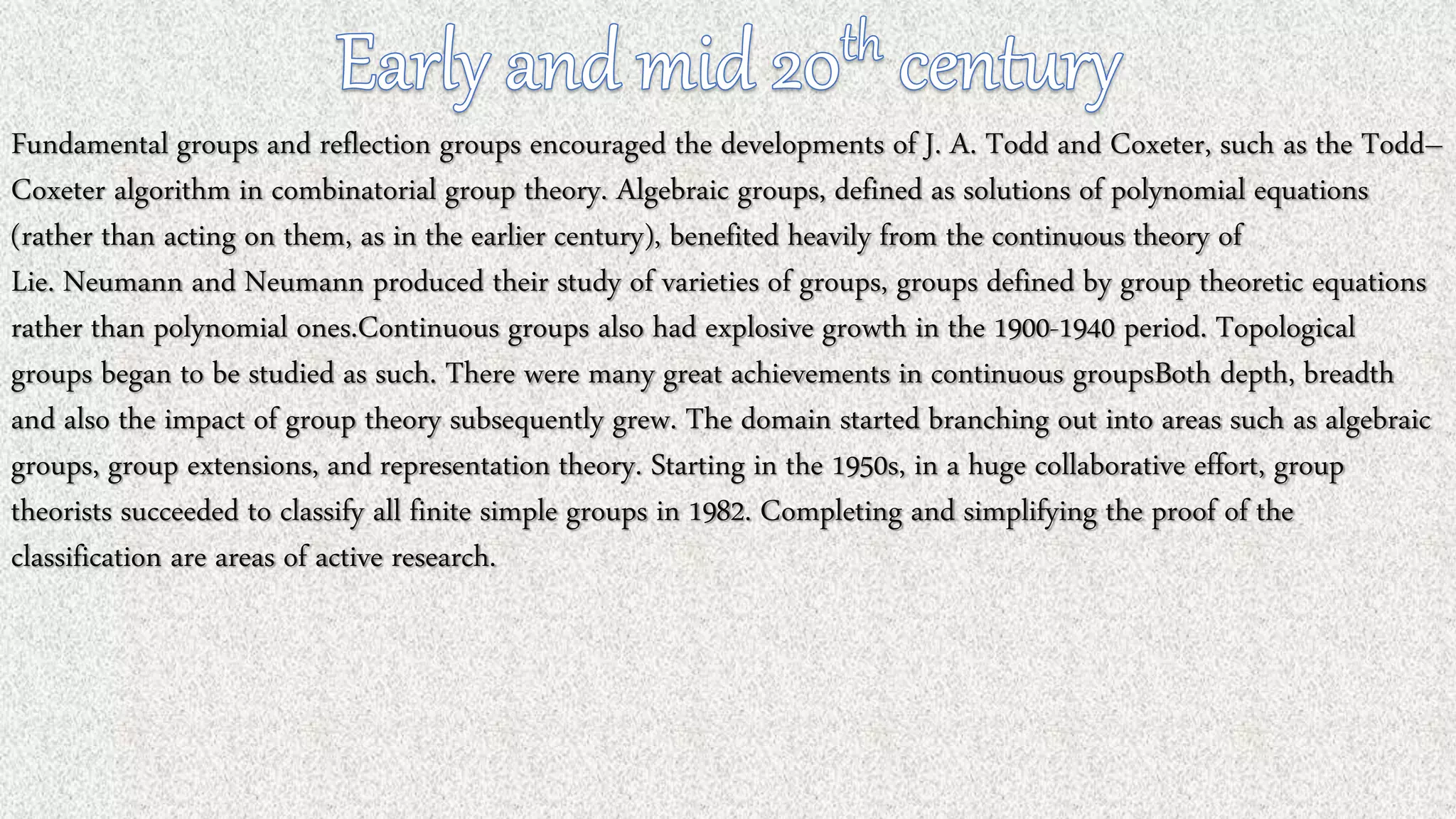



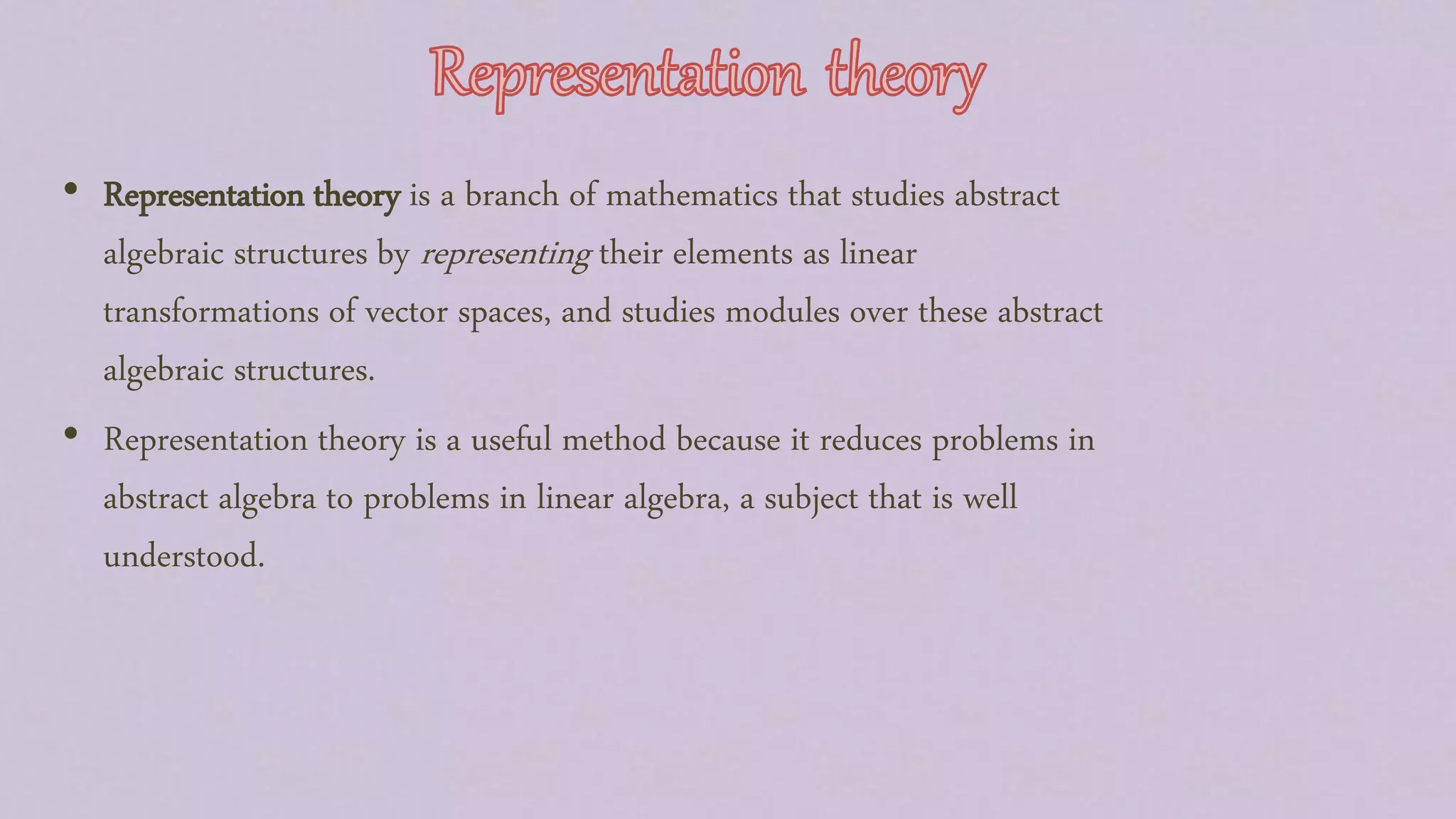




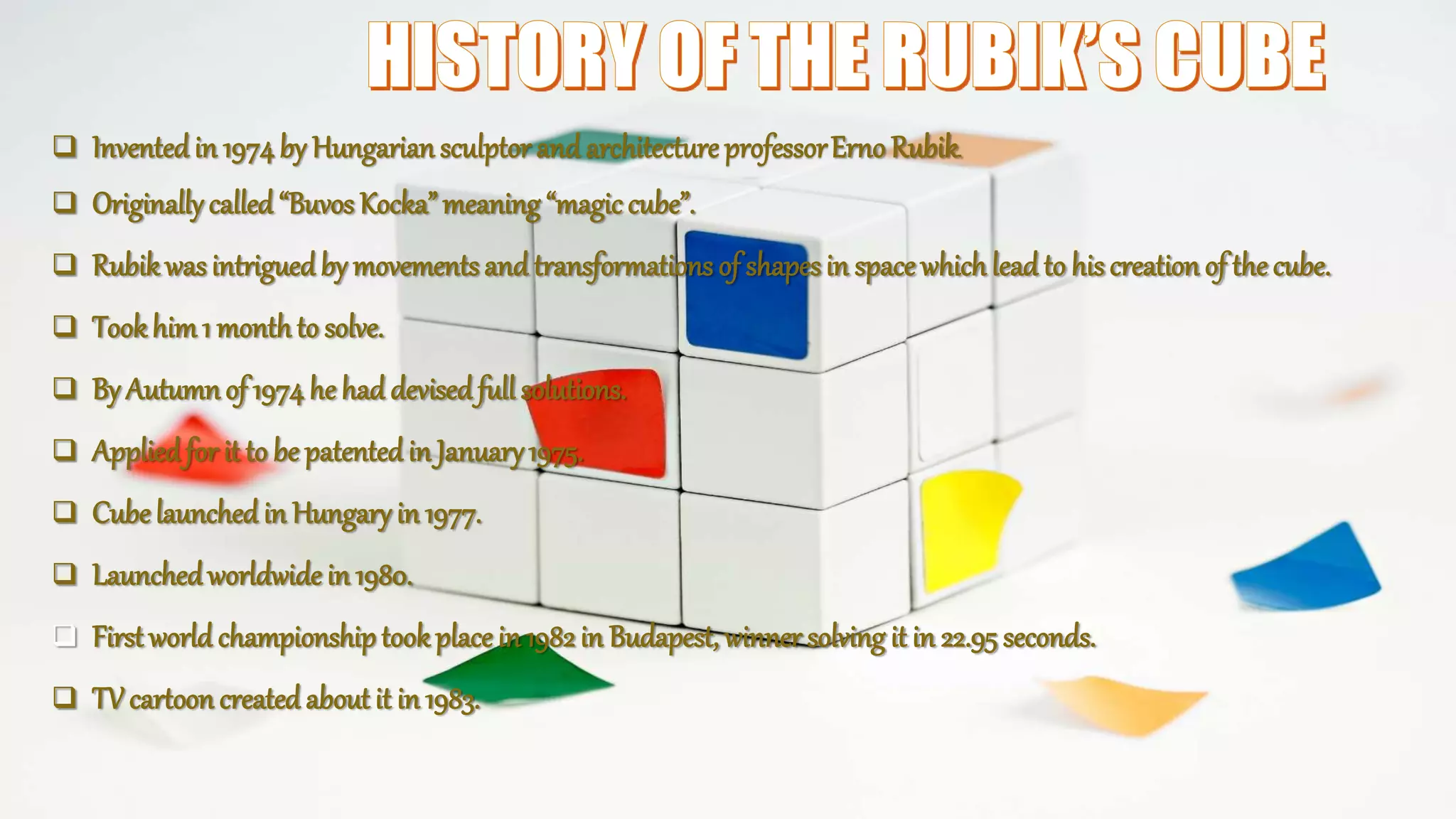
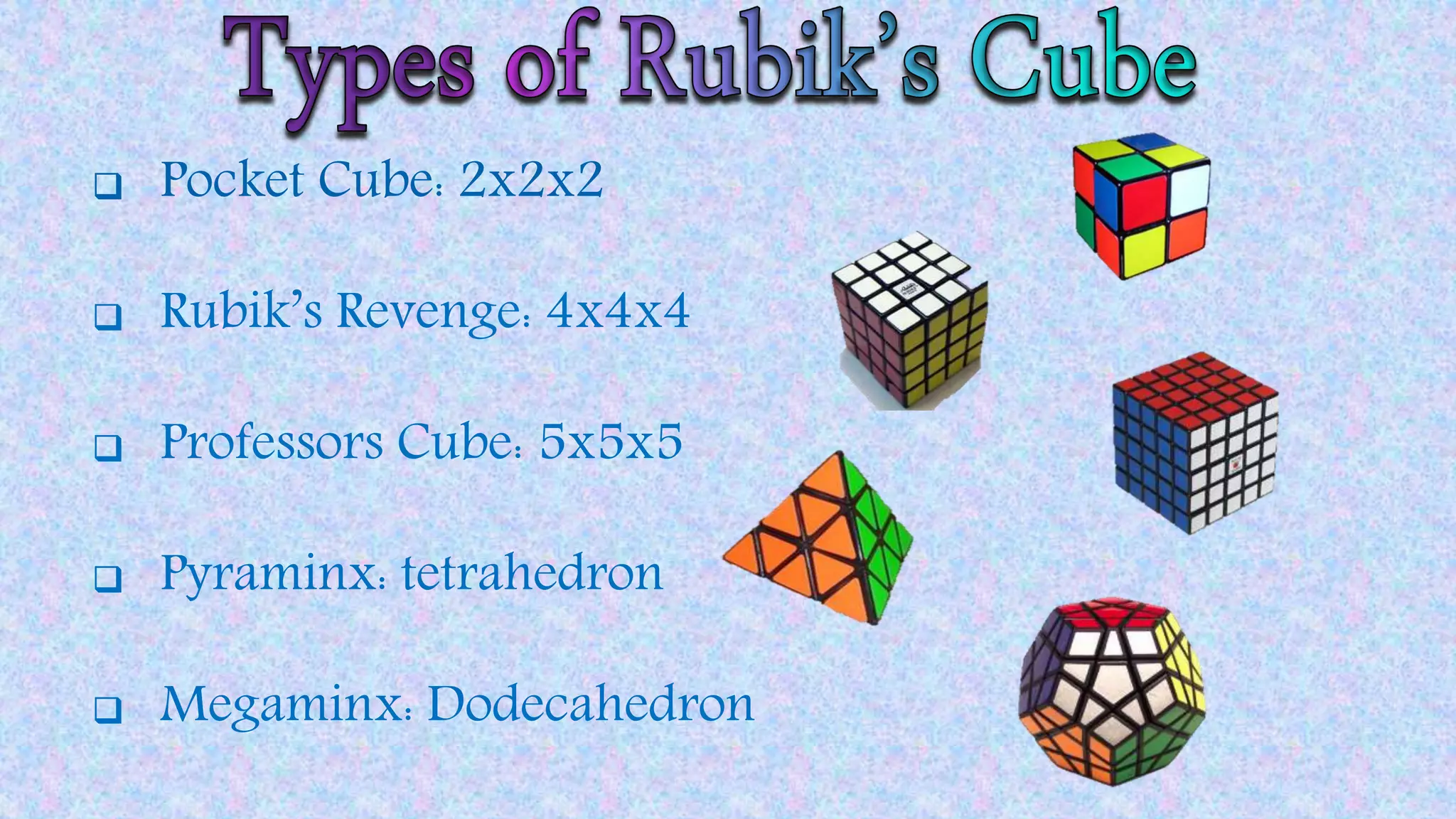
![ Pocket Cube: 2x2x2
The Pocket Cube (also known as the Mini Cube or the Ice Cube) is the
2×2×2 equivalent of a Rubik's Cube. The cube consists of 8 pieces, all corners.
The number of possible positions of the cube is
The maximum number of turns required to solve the cube is up to 11 full turns, or up to 14
quarter turns.
For the miniature (2 × 2 × 2) Rubik’s cube, the two-generator subgroup (the number of
positions generated just by rotations of two adjacent faces) is of order 29,160. [2]
The two algorithms can be used to solve the last layer:
1.To fix the positions of the corners:(U R U' L' U R' U' L)
2.To adjust the corners:(D R' D' R)
Rubik’sRevenge: 4x4x4
The Rubik's Revenge (also known as the Master Cube) is a 4×4×4 version of Rubik's Cube. It was
released in 1981.
Invented by Péter Sebestény, the Rubik's Revenge was nearly called the Sebestény Cube until a
somewhat last-minute decision changed the puzzle's name to attract fans of the original Rubik's
Cube.
Unlike the original puzzle (and the 5×5×5 cube), it has no fixed facets: the centre facets (four per
face) are free to move to different positions.](https://image.slidesharecdn.com/grouptheory-160123130813/75/Group-theory-18-2048.jpg)
![ This gives a total number of permutations of
The full number is 7401196841564901869874093974498574336000000000 possible permutations
(about 7401 septillion or 7.4 septilliard on the long scale or 7.4 quattuordecillion on the short scale).
Professors Cube: 5x5x5
The Professor's Cube is a mechanical puzzle, a 5×5×5 version of the Rubik's Cube.
It has qualities in common with both the original 3×3×3 Rubik's Cube and the 4×4×4Rubik's Revenge,
and knowing how to solve either can help when working on the 5×5×5 cube.
There are 54 centers. Six of these (the center square of each face) are fixed in position. The rest
consist of two sets of 24 centers. Within each set there are four centers of each color.
Each set can be arranged in 24! different ways. Assuming that the four centers of each color in each
set are indistinguishable, the number of permutations of each set is reduced to 24!/(4!6)
arrangements, all of which are possible.
This gives a total number of permutations of
The full number is precisely 282 870 942 277 741 856 536 180 333 107 150 328 293 127 731 985 672 134
721 536 000 000 000 000 000 possible permutations[7] (about 283 duo decillion on the long scale or
283 tresvigintillion on the short scale).](https://image.slidesharecdn.com/grouptheory-160123130813/75/Group-theory-19-2048.jpg)
![ Pyraminx: tetrahedron
The Pyraminx is a regular tetrahedron puzzle in the style of Rubik's Cube. It was made
and patented by Uwe Mèffert after the original 3 layered Rubik's Cube by Erno Rubik,
and introduced by Tomy Toys of Japan (then the 3rd largest toy company in the world) in
1981. The maximum number of twists required to solve the Pyraminx is 11. There
are 933,120 different positions (disregarding rotation of the trivial tips), a
number that is sufficiently small to allow a computer search for optimal
solutions.
Megaminx: Dodecahedron
The current world record for a single solve of the Pyraminx stands at 1.32
seconds, set by Drew Brads at the Lexington Fall 2015.[2] The best average
time of 2.52 seconds is held by Drew Brads done at Lexington Fall 2015.
The Megaminx is a dodecahedron-shaped puzzle
similar to the Rubik's Cube. It has a total of 50 movable
pieces to rearrange, compared to the 20 movable pieces
of the Rubik's Cube.
There are 30!/2 ways to arrange the edges and 229 ways to flip them.
The full number is 100 669 616 553 523 347 122 516 032 313 645 505 168 688 116 411 019 768 627 200
000 000 000 (roughly 101 unvigintillion on the short scale or 101 undecillionth on the long scale).](https://image.slidesharecdn.com/grouptheory-160123130813/75/Group-theory-20-2048.jpg)

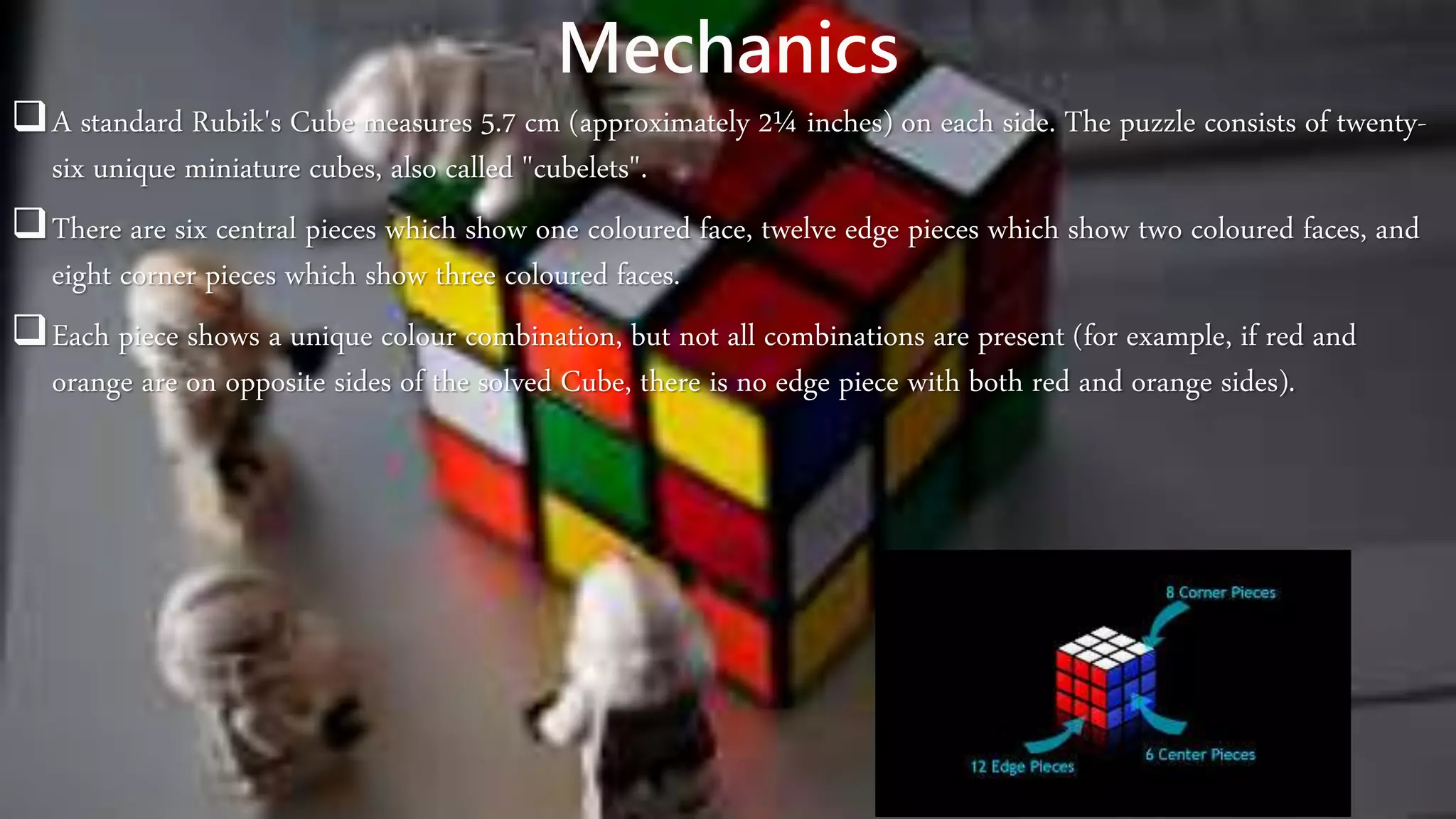



![ Rami Sbahi (USA) holds the current world record for solving the Pocket Cube in competition, with a time of
0.58 seconds at the Canadian Open 2015.
The best average of five consecutive solves in competition is 1.51 seconds, set by Lucas Etter (USA) at the
Music City Speedsolving 2015 competition. The times in his average, of which the best and worst are
dropped, were (1.24), 1.69, (2.21), 1.45, and 1.39.
Single time: The current world record for single time on a 3×3×3 Rubik's Cube was set by Lucas Etter of the
United States in November 2015 with a time of 4.90 seconds at the River Hill Fall 2015 competition in
Clarksville, Maryland.[58]
Average time: The world record for average time per solve was set by Feliks Zemdegs at the Melbourne
Cube Day 2013, with a 6.54 second average solve time.
One-handed solving: The fastest single time of solving the cube with one hand is 6.88 seconds by Feliks
Zemdegs at the Canberra Autumn 2015. The fastest average time of 10.87 seconds was made by Antoine
Cantin at the Toronto Spring 2015.
Feet solving: Jakub Kipa solved a Rubik's Cube with his feet in 20.57 seconds at the Radomsko Cube
Theory 2015. Gabriel Pereira Campanha got an average of 3 solves of 28.41 at the SESC Santos 2015.
Blindfold solving: The record for blind solving is held by Kaijun Lin (林恺俊) of China, who solved a cube
blindfolded in 21.05 seconds (including memorization) at China Championship 2015.[65]
Multiple blindfold solving: The record is held by Marcin Kowalczyk of Poland, who successfully solved 41 of 41
cubes blindfolded at the SLS Swierklany 2013.
Fewest moves solving: Tim Wong of the United States holds the record of 19 moves set at the Irvine Fall 2015.
Non-human solving: The fastest non-human time for a physical 3×3×3 Rubik's Cube is 3.25 seconds, set by
CubeStormer III, a robot built using Lego Mindstorms and a Samsung Galaxy S4.[66] This beats the prior
5.27 seconds, set by CubeStormer II, a robot built using Lego Mindstorms and a Samsung Galaxy S2.](https://image.slidesharecdn.com/grouptheory-160123130813/75/Group-theory-26-2048.jpg)






